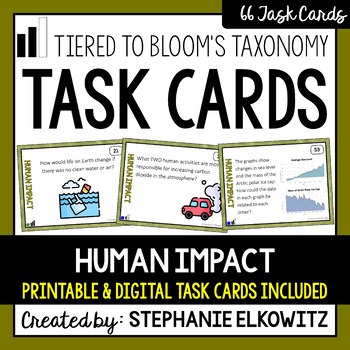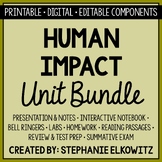Human Impact Task Cards | Printable & Digital
- Zip
- Google Apps™

What educators are saying
Also included in
- SAVE 35% by purchasing ALL of my Earth Science Task Cards!About this Product:• This product includes PRINTABLE AND DIGITAL task cards.• Task cards are tiered to Bloom's Taxonomy and probe low, mid and higher order thinking. • Quick Prep – two cuts produce printable task cards with a neat and even whPrice $46.80Original Price $72.00Save $25.20
- SAVE 40% by purchasing ALL my DIFFERENTIATED and TIERED Task Cards!About this Product• This product includes PRINTABLE AND DIGITAL task cards.• Task cards are tiered to Bloom's Taxonomy and probe low, mid and higher order thinking. • Quick Prep – two cuts produce printable task cards with a neat andPrice $171.90Original Price $286.50Save $114.60
- Save 40% by purchasing ALL my aligned Human Impact teaching materials!Important Notes:• Download a FREE Unit Bundle to learn more about all my products.• Save $$$ with the Earth Science Complete Curriculum• Save $$$$ with the Integrated Science Complete Curriculum• Consider Daily Lessons as an econoPrice $98.70Original Price $164.50Save $65.80
Description
About this Product
• This product includes PRINTABLE AND DIGITAL task cards.
• Task cards are tiered to Bloom's Taxonomy and probe low, mid and higher order thinking.
• Quick Prep – two cuts produce printable task cards with a neat and even white border.
• Digital task cards are made with Google Forms - Google Classrooms are not required.
• Answer Key included
Important Notes:
• Download FREE Task Cards to learn more about my task card sets
• Save $$$ with the Earth Science Complete Curriculum
• Save $$$$ with the Integrated Science Complete Curriculum
Topics Covered:
Earth’s Resources
Human Impact on the Environment
Negative Environmental Impact
Pollution
Air Pollution
Water Pollution
Acid Rain
Land Pollution
Ozone Depletion
Global Warming
Evidence for Climate Change
Human Population Growth
Human Impact on Other Species (Invasive Species, Direct Harvesting, Deforestation)
Biological Magnification
Conservation & Sustainability
Solving Environmental Problems
*********************************************************************************************************
Can my students use Digital Task Cards?
• You do NOT need Google Classroom or a specific app to use digital task cards.
• Google Form task cards can be shared as a link with your student any way you choose.
• Internet access is required.
• Google Form task cards can be completed on any electronic device including computers, tablets and smartphones.
How can I share Digital Task Cards with my students?
You can share digital task card sets with your students using secure methods including:
• Email directly to students
• Google Classrooms and Microsoft Teams
• Secure platforms such as Blackboard, Canvas and Schoology
• Password-protected file-sharing platforms such as DropBox, Google Drive or One Drive
Is this resource editable?
• Digital task card questions and answers are editable. Task card images are NOT editable.
• You can create smaller sets of task cards from this complete unit set of task cards.
• You can edit short answer responses to become multiple choice questions if desired.
• The task cards are designed to quiz students. You can adjust the settings to your preferences.
*********************************************************************************************************
Differentiation and Tiering
A colored shape code is denoted to help you differentiate concepts:
• Questions with a green circle cover basic ideas and understandings.
• Questions with a blue square cover intermediate ideas and understandings.
• Questions with a black diamond cover advanced ideas and understandings.
Each task card is marked with a "signal strength" to probe lower, mid or higher order thinking:
• Questions with a “low” signal strength assess the ability to remember, recall and understand
• Questions with a “medium” signal strength assess the ability to apply, analyze or explain
• Questions with a “high” signal strength assess the ability to evaluate, judge or interpret
Important Note: Some task card sets do NOT include all levels of differentiation. All task card sets include low, medium and high signal strength questions for each differentiation level included. Refer to the preview for the levels included with this task card set.
*********************************************************************************************************
These task cards are great for:
✓ Science Centers
✓ Formative or Summative Assessment
✓ Scoot Classroom Game
✓ Independent Study
✓ Review
NGSS Alignment
• This resource supports NGSS 5-ESS3-1, MS-ESS3-3, MS-ESS3-4 and MS-ESS3-5.
TERMS OF USE
• All rights reserved by Stephanie Elkowitz.
• This product is to be used by the original purchaser only.
• Intended for classroom and personal use only.
• Copying for more than one teacher, classroom, department, school, or school system is prohibited.
• This product may not be distributed or displayed digitally for public view.
• Failure to comply is a copyright infringement and a violation of the Digital Millennium Copyright Act (DMCA).





